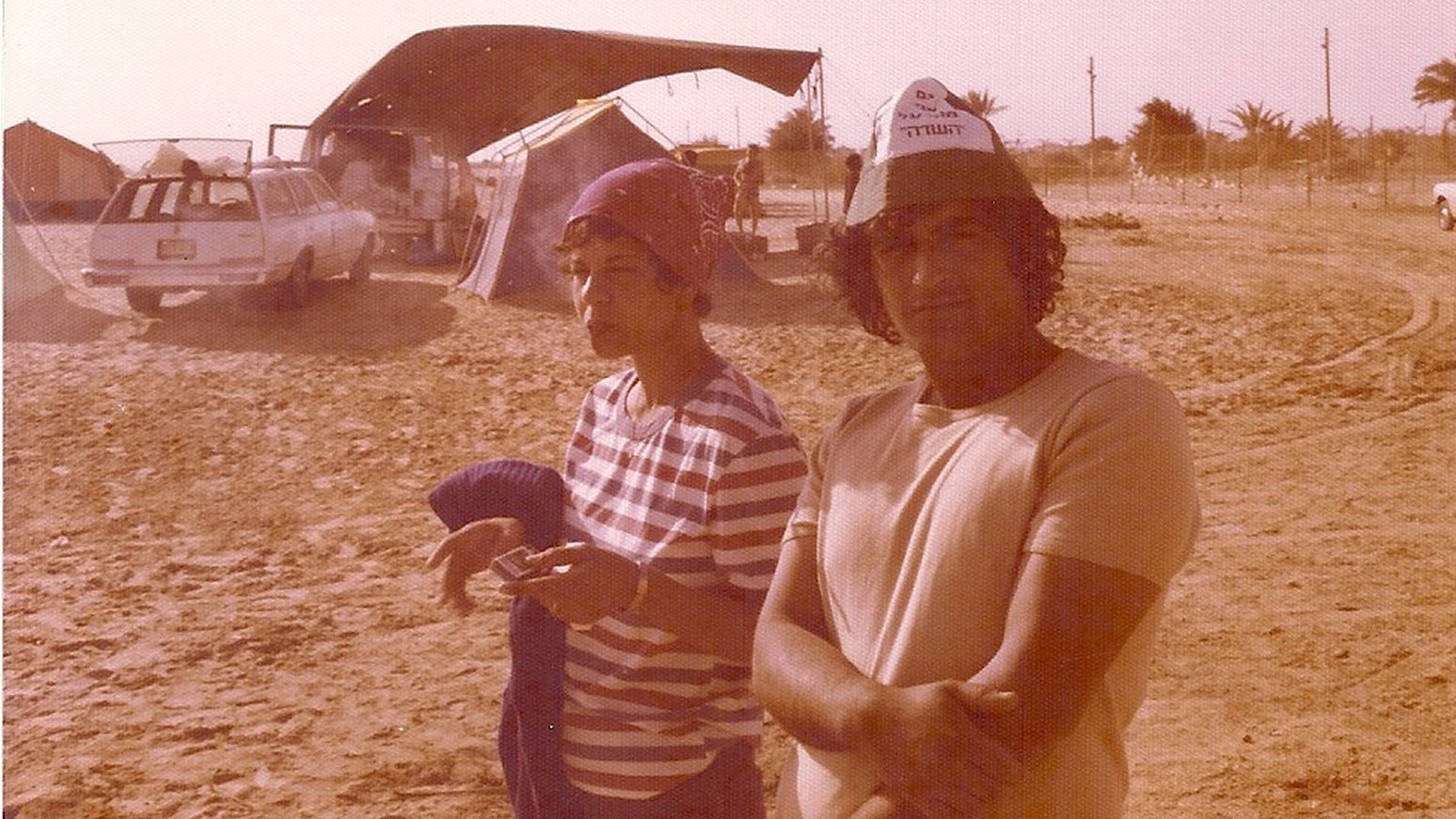Go Down, Moses: Israelis Recall Life in Sinai 40 Years On
Farmers flock to Nitzana region on Egyptian border in hopes of making desert bloom
When Nira and Alon Zadok left the wilderness of Egypt 40 years ago, they chose to put down roots in the wilderness of Israel, in one of the most remote areas of the country.
Surrounded by rocky ridges and sand dunes, the small Israeli town of Kadesh Barnea is situated in the western Negev desert on the Egyptian border.
The town was named after an important biblical site as well as a tiny settlement in the Sinai Peninsula where the Zadoks lived from 1977 to 1980. In the Bible, Kadesh Barnea was the place where the Israelites set up camp during their wandering in the Sinai Desert, as well as the place from which they sent Joshua and Caleb to spy on the land of Canaan.
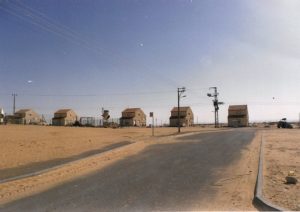
The Israeli town of Kadesh Barnea in the Negev, in its early days in this 1986 photo. (Courtesy)
After the peace agreement with Egypt, Israel withdrew from the Sinai and thousands of Israelis were forced to relocate. The pullout was completed on April 26, 1982.
Overlooking the broad expanse of the Sinai Peninsula, Kadesh Barnea is about as close as the Zadoks could get to their original home.
“There is something primeval and wonderful about the Sinai,” Nira Zadok, co-owner of Ramat Negev Winery, told The Media Line. “For someone who is fully motivated and has the strength to do things, that’s the place to be. I felt that that was where I found myself.”
During their short stay in the Sinai, the Zadoks also dreamed of settling in a nearby oasis believed to be the true biblical location of Kadesh Barnea.
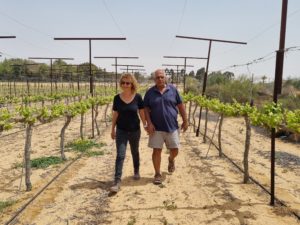
Nira and Alon Zadok, owners of the Ramat Negev Winery in the town of Kadesh Barnea, on April 11, 2022. (Maya Margit/The Media Line)
Once the Egypt-Israel peace treaty was signed, however, all of those dreams went out the window.
“There was hope that we’d be able to return someday, and this factored into our decision to live near the Egyptian border,” she said. “We thought we would wait until the border reopened and that the peace agreement would fail. But there is still peace.”
Even though they were quite young at the time, life in the Sinai was challenging, Alon Zadok, co-owner of the winery, recounts.
“We founded a settlement that’s about 9 km (less than 6 miles) from here within the Sinai Peninsula,” he said. “We were seven people in all: my wife and I, and five other singles.
“I think that the Israeli withdrawal from the Sinai was the right thing to do, it was worth it and important,” Alon Zadok added. “We’ve been here for 40 years and there are no incidents on the border – it’s truly a peaceful border.”
The Zadoks are among the founding families of Kadesh Barnea and the first to establish a winery in the Negev.
They planted their first grapevines in 1995. Initially, the Ramat Negev Winery produced 3,000 bottles annually; that number has since skyrocketed to more than 250,000 bottles per year.
Early on, it was difficult to convince people that quality wine could be produced in a harsh desert climate.
“We were the first to grow grapes in the Negev and market the wine here in Israel,” Alon Zadok said.
In 2020, the Merage Foundation established the Negev Wineries Club, which includes over 25 wineries, in a bid to promote winemaking in the region and draw tourism to the area. The foundation’s efforts have helped spur a grape-growing revolution in the desert, according to Alon.
“I believe that within another four to five years there will be at least another five vineyards that are the same size as us,” he said.
Nitzana: Past, Present and Future
The town of Kadesh Barnea is part of the wider Nitzana region: a land that in many ways connects the past, present and future of Israel.
Because it also served to connect Africa to Asia, several civilizations passed through the area over the millennia, including the Nabateans, Romans, Byzantines, Ottomans and British. The archaeological site of Nitzana features impressive remnants from many of these peoples, including a 1,500-year-old Byzantine church and the ruins of German-Turkish hospital built at the turn of the 20th century.
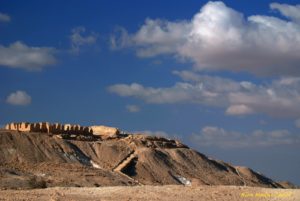
A view of the Nitzana archaeological site. (Nira Zadok)
According to tour guide Chen Biron, Nitzana played a particularly important role during the Byzantine era when it became a pit stop for Christian pilgrims making their way to Saint Catherine’s Monastery in the Sinai, located near what some believe to be the biblical Mount Sinai. At the height of those pilgrimages, some 1,500 people lived in the Nitzana valley.
Though there is no archaeological evidence to prove it, many also hypothesize that the ancient Israelites walked through the area on their way to Egypt.
“The geography of the Bible and that we live today is the same,” Biron told The Media Line. “The mountains of Judea, Hebron and Jerusalem are the same. That is why I know that that is the only way Abraham had to go through and go to Egypt. If Abraham was walking to Egypt, it’s from here.”
Building on that biblical past, many new Israeli pioneers have recently moved to the Nitzana region, with some citing the early Zionist dream of making the desert bloom as being a key motivator.
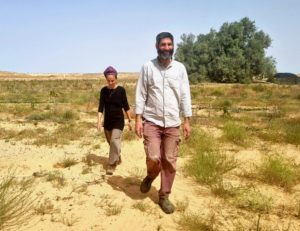
Roni and Gal Tushia walk near the Tamarisk tree on April 11, 2022, the only thing they found when they first got their plot of land in the Nitzana region. (Maya Margit/The Media Line)
Roni and Gal Tushia own the Tushia Organic Farm in the nearby town of Be’er Milka and have focused their farming efforts on growing the Seven Species: seven agricultural products listed in the Bible as being special to the Holy Land.
“We are settling the Egyptian border area,” Roni Tushia related. “We need people to come and live here. This is our land, so we’re settling it and making the desert bloom. We’re getting more rain thanks to the agriculture here.”
The Tushia farm includes a vineyard, a wide array of fruit trees, pineapples and olive trees.
However, when the family first arrived 11 years ago, there were only sand dunes and a lone tamarisk tree to greet them.
“There were many challenges in the beginning,” Gal Tushia said. “There was no place where we could buy food so we had to travel to the city of Beersheba, we had to store jerrycans filled with gas for our car. Our car would get stuck in the sand near our caravan. But all this gives us a special sense of being pioneers, which you can’t get in central Israel.”
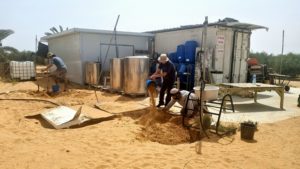
Volunteers help out with farm work on the Tushia Organic Farm. Photo taken on April 11, 2022. (Maya Margit/The Media Line)
Learning how to grow produce in the desert was yet another monumental challenge the family had to overcome and, according to Gal Tushia, they had to learn how to do everything from scratch.
But for those who choose to live in the remote parts of the Negev, the pioneer life is ultimately worth the struggles, the hard work and the sacrifice, she says.
“There’s a saying that one day every grain of sand in the Land of Israel will be worth its weight in gold,” Gal Tushia related. “If you look around there’s a lot of sand here. We’re patient; we’ll wait until it happens. It’s already worth its weight in gold because it’s the land of Israel.”

